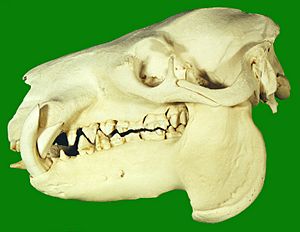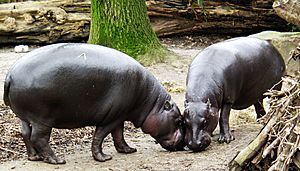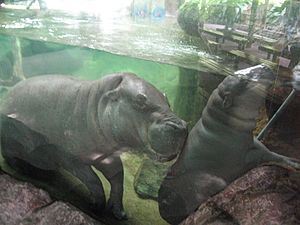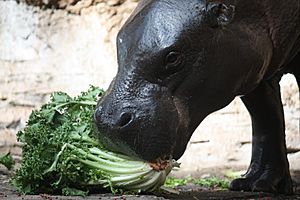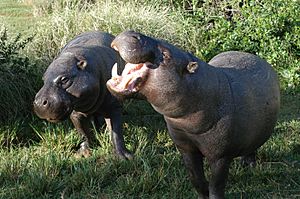Pygmy hippopotamus facts for kids
Quick facts for kids Pygmy hippopotamus |
|
|---|---|
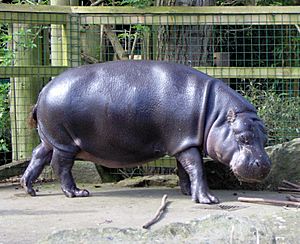 |
|
| Pygmy hippopotamus at Bristol Zoo in United Kingdom | |
| Conservation status | |
| Scientific classification (disputed) |
|
| Genus: |
Hexaprotodon
|
| Species: |
liberiensis
|
| Subspecies | |
|
|
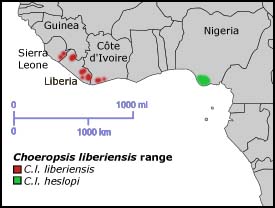 |
|
| Range map | |
| Synonyms | |
|
|
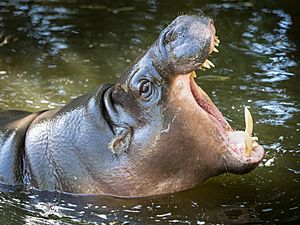
The pygmy hippopotamus is a small hippo that lives in the forests and swamps of West Africa. You can find them mainly in Liberia, with smaller groups in Sierra Leone, Guinea, and Ivory Coast.
These hippos are shy and mostly active at night. They are one of only two types of hippos still alive today. The other is the much bigger common hippopotamus. Pygmy hippos spend time on land, but they also need water. Water helps keep their skin wet and their bodies cool. They might even mate and have babies in the water or on land. Pygmy hippos eat plants like ferns, broad-leaved plants, grasses, and fruits from the forest.
It's hard to study pygmy hippos in the wild because they are rare and live hidden in forests. People outside West Africa didn't know about them until the 1800s. They were brought to zoos in the early 1900s. Pygmy hippos breed well in zoos, so most of what we know comes from animals in captivity. Experts believe fewer than 3,000 pygmy hippos are left in the wild.
The biggest danger to pygmy hippos is losing their homes. Forests are cut down for farms and wood. They are also hunted for their meat and face threats from natural predators and wars.
Contents
Meet the Pygmy Hippopotamus
A baby pygmy hippo is called a calf. A male is a bull, and a female is a cow. A group of hippos is known as a "herd" or a "bloat."
Pygmy hippos belong to the hippo family, called Hippopotamidae. Scientists sometimes call them Choeropsis liberiensis or Hexaprotodon liberiensis. The name Choeropsis means "looks like a hog." Hexaprotodon means "six front teeth."
Long ago, there was another small hippo in Madagascar. It was called the Malagasy pygmy hippopotamus. It was about the same size as the pygmy hippo we know today. It lived in forests, not rivers. This hippo likely died out about 500 years ago.
Scientists have studied how pygmy hippos are related to other animals. For a long time, people thought hippos were closest to pigs. But newer research shows that hippos and whales are actually close relatives! They both came from a common ancestor that lived about 60 million years ago. This ancestor was semi-aquatic, meaning it lived partly in water.
What Pygmy Hippos Look Like
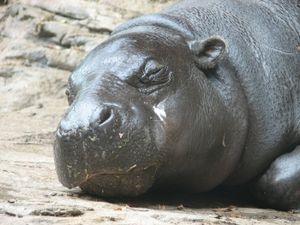
Pygmy hippos look like smaller versions of common hippos. They have short, strong legs and four toes on each foot. An adult pygmy hippo is about half as tall as a common hippo. It weighs less than a quarter of what a common hippo does.
Adult pygmy hippos stand about 75 to 100 centimeters (2.5 to 3.3 feet) tall at the shoulder. They are about 150 to 175 centimeters (5 to 5.7 feet) long. They weigh between 180 and 275 kilograms (397 to 606 pounds). In zoos, they can live for 30 to 55 years. They probably don't live as long in the wild.
Their skin is greenish-black or brown, fading to gray on their belly. Like common hippos, their skin makes a special pinkish liquid. People sometimes call it "blood sweat," but it's not blood or sweat. This liquid helps protect their skin from germs and the sun. Hippo skin dries out quickly and cracks, which is why they spend so much time in water.
Pygmy hippos have a more slender body than common hippos. Their back slopes forward, which helps them move through thick forest plants. Their legs and neck are longer, and their head is smaller.
Their eyes and nostrils are not as noticeable as those of common hippos. This is because pygmy hippos spend less time in deep water. Common hippos need their eyes and nostrils to stick out to see and breathe underwater. Pygmy hippos have wider feet with more spread-out toes. This helps them walk on the forest floor.
Even though they spend more time on land, pygmy hippos still need water. Their ears and nostrils have strong muscles that close when they go underwater. Their skin also needs water to stay healthy.
Pygmy Hippo Behavior
Pygmy hippos act differently from common hippos. Common hippos live in large groups, but pygmy hippos usually live alone or in small pairs. They might be a mated couple or a mother and her baby. When they meet other pygmy hippos, they usually ignore each other instead of fighting. Male pygmy hippos roam over larger areas than females.
Pygmy hippos hide in rivers for most of the day. They might stay in the same spot for several days before moving. Some pygmy hippos use dens or burrows in river banks. We don't know if they dig these dens themselves.
What Pygmy Hippos Eat
Like common hippos, pygmy hippos come out of the water at night to find food. They use trails through the thick forest. They mark these trails by wagging their tail while pooping, which spreads their waste around. Pygmy hippos spend about six hours a day looking for food.
Pygmy hippos are plant-eaters. They don't eat much water plants or grass, because grass is rare in their dense forest homes. They mostly eat ferns, broad-leaved plants, and fruits that have fallen to the ground. They seem to eat any plants they can find. Their diet is richer in nutrients than what common hippos eat.
Pygmy Hippo Reproduction and Life Cycle
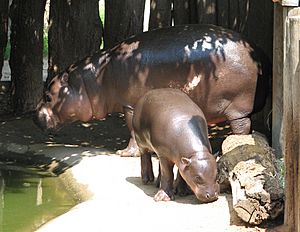
A female pygmy hippo is pregnant for about 190 to 210 days. Usually, she gives birth to one baby, but sometimes twins are born.
Common hippos only mate and give birth in the water. Pygmy hippos can do both on land or in water.
Baby pygmy hippos can swim almost right away. When they are born, they weigh about 4.5 to 6.2 kilograms (9.9 to 13.7 pounds). Males are slightly heavier than females. Babies stop drinking milk when they are six to eight months old. Before that, they don't go with their mother when she leaves the water to find food. Instead, they hide in the water alone. The mother comes back about three times a day to feed her calf. She lies on her side while the baby drinks milk.
Protecting Pygmy Hippos
The biggest danger to pygmy hippos in the wild is losing their habitat. The forests where they live are being cut down for wood and to make space for farms. Not enough is being done to make logging sustainable. As forests shrink, pygmy hippo groups become separated. This means they have fewer choices for mates, which can harm their health over time.
Pygmy hippos are sometimes hunted illegally for food in Liberia. Their meat is said to be very good. Unlike common hippos, the teeth of pygmy hippos are not valuable. Wars in West Africa have also likely harmed pygmy hippo populations, but we don't know the full impact. Pygmy hippos can be hunted by leopards, pythons, and crocodiles. How often this happens is not known.
Basel Zoo in Switzerland helps manage the pygmy hippo population in zoos worldwide. They keep a special record book for them. Between 1970 and 1991, the number of pygmy hippos born in zoos more than doubled. It is more certain that the species will survive in zoos than in the wild. In captivity, pygmy hippos live longer, from 42 to 55 years. Since 1919, only 41 percent of pygmy hippos born in zoos have been male.
Images for kids



